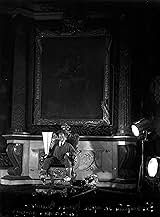IMDb RATING
7.4/10
8.6K
YOUR RATING
A large-scale view on the events of 1917 in Russia, when the monarchy was overthrown.A large-scale view on the events of 1917 in Russia, when the monarchy was overthrown.A large-scale view on the events of 1917 in Russia, when the monarchy was overthrown.
- Awards
- 1 win total
- Directors
- Writers
- All cast & crew
- Production, box office & more at IMDbPro
Storyline
Did you know
- TriviaThe filming of the assault on the Winter Palace required 11,000 extras, and the lighting needs left the rest of the city blacked out.
- GoofsThe Bolshevik revolutionary killed by the mob can be seen blinking his eyes after dead. He is lying on the bank of the Neva River, and reacts slightly (in a close-up) when water splashes over his face.
- Quotes
V.I. Lenin: [at the Finland Station] Long live the socialist revolution! All power to the Soviets! Socialist, not bourgeois! Capitalist ministers give you neither peace, nor bread, nor land!
- Crazy creditsOnly under the iron leadership of the Communist Party can the victory of the masses be secured.
- Alternate versionsA restored version was finished in Moscow in October/November 2007, adding material and correcting the timing, growing the length of the movie (compared to the 1967 version, the restored version hitherto usually screened) by about half an hour. The added material includes shots of (an actor playing) Leonid Trotsky, shots which Sergey Eisenstein is said to have removed from the film during the editing process by order from Stalin himself.
- ConnectionsEdited into Ten Days That Shook the World (1967)
Featured review
I first saw this film in the late 80s at the NFT (UK National Film Theatre) with a piano accompaniment. The print was scratchy and the inter-titles longer than several of the scenes. I was expecting it to be interesting as an example of Eisenstein's use of montage and cross-cutting (and indeed the audience seemed to be composed mainly of film students), thus worthy and perhaps a little dull. Instead, I was stunned. Now released on DVD with a Shostakovitch score and sparse sound effects, the film is revealed as masterpiece which surpasses both Battleship Potyomkin (1925) and Alexander Nevsky (1938) in its use of these two, and many more, filmic devices.
It's a young man's film and completely of its time and place, that is to say it gives a romanticised and idealised view of the Bolshevic revolution and its origins. The Tsar is directly compared to a horse's arse, Lenin harangues from the front of a steam engine, the proletariat are the true beneficiaries of the revolution. Statues fall apart and are re-formed in reverse motion, the people re-enact the storming of the winter palace (and climb its real gates), the battles cross-cut from faces and hands to carefully staged set pieces. In the second most famous sequence in early film history (the other being the Odessa steps from Potyomkin), a young woman's hair flops over the edge of a rising bridge while a cart and dead horse drop into the water.
The film is politically naive but decades ahead of its time in every other respect. The young people who inhabit these pages might like to compare its editing and pacing with that of the average music video and CGI-driven special effects film. I contend there is essentially nothing in these which they will not find in Eisenstein, and in October (Oktyabr) in particular. Yes, it's black and white, and silent but for the lately added score, and yes, it's from the early 20th century (by no means the earliest history of film), but it still stuns after repeated viewing. This is where modern film-making started, and everything we think we know about it (slow motion, montage, cross-cuts, reverses, you name it) had its origins in Eisenstein. The inter-titles (not sub-titles) still go on too long, though.
It's a young man's film and completely of its time and place, that is to say it gives a romanticised and idealised view of the Bolshevic revolution and its origins. The Tsar is directly compared to a horse's arse, Lenin harangues from the front of a steam engine, the proletariat are the true beneficiaries of the revolution. Statues fall apart and are re-formed in reverse motion, the people re-enact the storming of the winter palace (and climb its real gates), the battles cross-cut from faces and hands to carefully staged set pieces. In the second most famous sequence in early film history (the other being the Odessa steps from Potyomkin), a young woman's hair flops over the edge of a rising bridge while a cart and dead horse drop into the water.
The film is politically naive but decades ahead of its time in every other respect. The young people who inhabit these pages might like to compare its editing and pacing with that of the average music video and CGI-driven special effects film. I contend there is essentially nothing in these which they will not find in Eisenstein, and in October (Oktyabr) in particular. Yes, it's black and white, and silent but for the lately added score, and yes, it's from the early 20th century (by no means the earliest history of film), but it still stuns after repeated viewing. This is where modern film-making started, and everything we think we know about it (slow motion, montage, cross-cuts, reverses, you name it) had its origins in Eisenstein. The inter-titles (not sub-titles) still go on too long, though.
- iain_connell
- Feb 3, 2005
- Permalink
Details
- Runtime1 hour 35 minutes
- Color
- Sound mix
- Aspect ratio
- 1.20 : 1
Contribute to this page
Suggest an edit or add missing content

Top Gap
By what name was October (Ten Days that Shook the World) (1927) officially released in India in English?
Answer






















